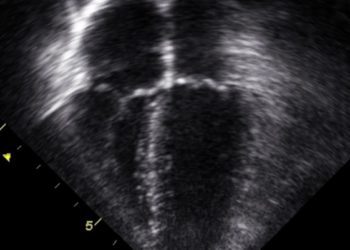Transfemoral transcatheter aortic valve replacement vs surgical valve replacement outcomes at 5 years
1. In this randomized clinical trial, there was no significant difference in all-cause mortality or disabling stroke at 5 years between patients who underwent transfemoral transcatheter aortic valve replacement or surgical aortic valve replacement in elderly patents with severe, symptomatic aortic stenosis.
Evidence Rating Level: 1 (Excellent)
Current guidelines recommend that elderly patients with severe, symptomatic aortic stenosis (AS) receive transfemoral transcatheter aortic valve replacement or surgical aortic valve replacement. Multiple previous clinical trials have been performed in elderly patients and have found similar outcomes between surgical aortic valve replacement and TAVR at 2 years post-procedure. However, further research with longer follow-up is important for proper counselling of patients with longer life expectancies. This SURTAVI trial compares outcomes, functional status, and valve performance after self-expanding TAVR or surgery 5 years post-procedure. Patients with sever symptomatic AS at intermediate operative risk were randomized 1:1 to TAVR with supra-annular self-expanding bioprosthesis or surgery, from June 2012 to June 2016 in 87 centers in Canada, Europe, or the United States. Patient assessments were performed at baseline, more frequently within the first year, and annually afterwards, with follow up planned to 10 years. In total, 1669 patients were included in the study, with 864 randomized to TAVR and 796 randomized to surgery. 5 year follow up was available for 603 (93.7%) of patients in the TAVR group and 426 (95.5%) of patients in the surgery group. The primary outcome was all-cause mortality or disabling stroke, occurring in 255 (31.3%) patients that underwent TAVR and 217 (30.8%) that underwent surgery, which was not a significant difference between the two groups. Furthermore, when stratified by revascularization, there was still no significant difference between the two groups. There was, however, a significant difference in valve reintervention, with the TAVR group having a higher incidence of requiring valve reintervention when compared to the surgery cohort (P=.02). With respect to valve performance, patients in the TAVR group had larger orifice areas and lower mean gradients than surgical patients at all time points (P<.001). Otherwise, there was no significant difference in functional improvement or status between the two groups. Overall, this study suggests no difference in all-cause mortality or disabling stroke between patients that received supra-annular self-expanding TAVR and surgical aortic valve replacement in patients with symptomatic severe aortic stenosis at an intermediate surgical risk. Further research into longer follow-ups between the two groups is important for proper counselling and education of patients considering either procedure in the future. Limitations of this study included that given the study population, results may not be applicable to younger patients. Furthermore, results may not be generalized to patients without self-expanding valves, or to patients with procedures performed outside of experienced TAVR centers.
Click to read the study in JAMA Cardiology
Image: PD
©2022 2 Minute Medicine, Inc. All rights reserved. No works may be reproduced without expressed written consent from 2 Minute Medicine, Inc. Inquire about licensing here. No article should be construed as medical advice and is not intended as such by the authors or by 2 Minute Medicine, Inc.







